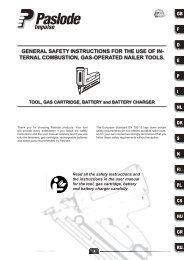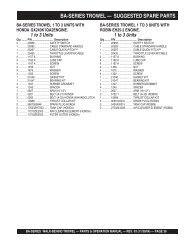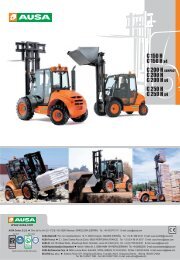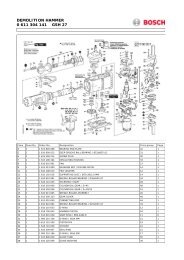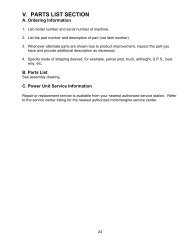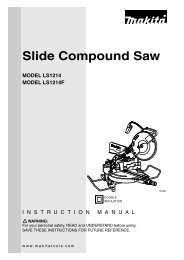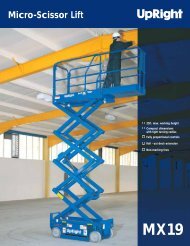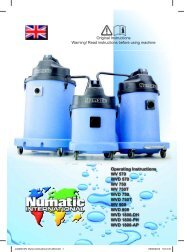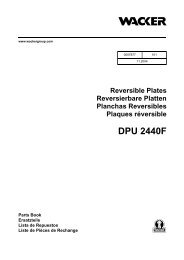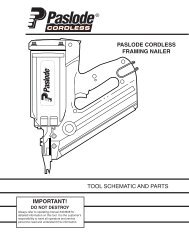Makita - 9015B - 5" Electric Angle Grinder - JW Hire & Sales Ltd
Makita - 9015B - 5" Electric Angle Grinder - JW Hire & Sales Ltd
Makita - 9015B - 5" Electric Angle Grinder - JW Hire & Sales Ltd
Create successful ePaper yourself
Turn your PDF publications into a flip-book with our unique Google optimized e-Paper software.
5. Avoid body contact with grounded surfaces<br />
such as pipes, radiators, ranges and<br />
refrigerators. There is an increased risk of<br />
electric shock if your body is grounded.<br />
6. Do not expose power tools to rain or wet<br />
conditions. Water entering a power tool will<br />
increase the risk of electric shock.<br />
7. Do not abuse the cord. Never use the cord<br />
to carry the tools or pull the plug from an<br />
outlet. Keep cord away from heat, oil,<br />
sharp edges or moving parts. Replace<br />
damaged cords immediately. Damaged<br />
cords increase the risk of electric shock.<br />
8. When operating a power tool outside, use<br />
an outdoor extension cord marked “W-A”<br />
or “W”. These cords are rated for outdoor<br />
use and reduce the risk of electric shock.<br />
Personal Safety<br />
9. Stay alert, watch what you are doing and<br />
use common sense when operating a<br />
power tool. Do not use tool while tired or<br />
under the influence of drugs, alcohol, or<br />
medication. A moment of inattention while<br />
operating power tools may result in serious<br />
personal injury.<br />
10. Dress properly. Do not wear loose clothing<br />
or jewelry. Contain long hair. Keep<br />
your hair, clothing, and gloves away from<br />
moving parts. Loose clothes, jewelry, or long<br />
hair can be caught in moving parts.<br />
11. Avoid accidental starting. Be sure switch<br />
is off before plugging in. Carrying tools with<br />
your finger on the switch or plugging in tools<br />
that have the switch on invites accidents.<br />
12. Remove adjusting keys or wrenches<br />
before turning the tool on. A wrench or a<br />
key that is left attached to a rotating part of<br />
the tool may result in personal injury.<br />
13. Do not overreach. Keep proper footing<br />
and balance at all times. Proper footing and<br />
balance enables better control of the tool in<br />
unexpected situations.<br />
14. Use safety equipment. Always wear eye<br />
protection. Dust mask, non-skid safety<br />
shoes, hard hat, or hearing protection must<br />
be used for appropriate conditions. Ordinary<br />
eye or sun glasses are NOT eye protection.<br />
Tool Use and Care<br />
15. Use clamps or other practical way to<br />
secure and support the workpiece to a<br />
stable platform. Holding the work by hand or<br />
against your body is unstable and may lead<br />
to loss of control.<br />
16. Do not force tool. Use the correct tool for<br />
your application. The correct tool will do the<br />
job better and safer at the rate for which it is<br />
designed.<br />
17. Do not use tool if switch does not turn it<br />
on or off. Any tool that cannot be controlled<br />
with the switch is dangerous and must be<br />
repaired.<br />
18. Disconnect the plug from the power<br />
source before making any adjustments,<br />
changing accessories, or storing the tool.<br />
Such preventive safety measures reduce the<br />
risk of starting the tool accidentally.<br />
19. Store idle tools out of reach of children<br />
and other untrained persons. Tools are<br />
dangerous in the hands of untrained users.<br />
20. Maintain tools with care. Keep cutting<br />
tools sharp and clean. Properly maintained<br />
tools with sharp cutting edges are less likely<br />
to bind and are easier to control.<br />
21. Check for misalignment or binding of<br />
moving parts, breakage of parts, and any<br />
other condition that may affect the tools<br />
operation. If damaged, have the tool serviced<br />
before using. Many accidents are<br />
caused by poorly maintained tools.<br />
22. Use only accessories that are recommended<br />
by the manufacturer for your<br />
model. Accessories that may be suitable for<br />
one tool, may become hazardous when used<br />
on another tool.<br />
SERVICE<br />
23. Tool service must be performed only by<br />
qualified repair personnel. Service or maintenance<br />
performed by unqualified personnel<br />
could result in a risk of injury.<br />
3



